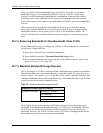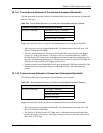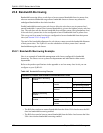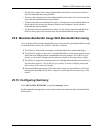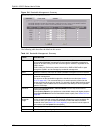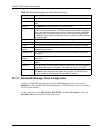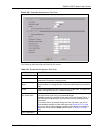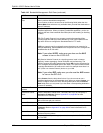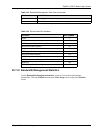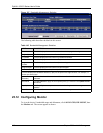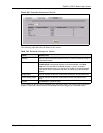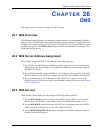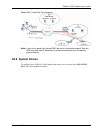
ZyWALL 5/35/70 Series User’s Guide
413 Chapter 25 Bandwidth Management
Enable Bandwidth
Filter
Select Enable Bandwidth Filter to have the ZyWALL use this bandwidth filter
when it performs bandwidth management.
You must enter a value in at least one of the following fields (other than the
Subnet Mask fields which are only available when you enter the destination or
source IP address).
Service This field simplifies bandwidth class configuration by allowing you to select a
predefined application. When you select a predefined application, you do not
configure the rest of the bandwidth filter fields (other than enabling or disabling
the filter).
FTP (File Transfer Program) is a program to enable fast transfer of files,
including large files that may not be possible by e-mail. Select FTP from the
drop-down list box to configure the bandwidth filter for FTP traffic.
H.323 is a protocol used for multimedia communications over networks, for
example NetMeeting. Select H.323 from the drop-down list box to configure the
bandwidth filter for H.323 traffic.
Note: If you select H.323, make sure you also use the ALG
screen to turn on the H.323 ALG.
SIP (Session Initiation Protocol) is a signaling protocol used in Internet
telephony, instant messaging, events notification and conferencing. The
ZyWALL supports SIP traffic pass-through. Select SIP from the drop-down list
box to configure this bandwidth filter for SIP traffic. This option makes it easier
to manage bandwidth for SIP traffic and is useful for example when there is a
VoIP (Voice over Internet Protocol) device on your LAN.
Note: If you select SIP, make sure you also use the ALG screen
to turn on the SIP ALG.
Select Custom from the drop-down list box if you do not want to use a
predefined application for the bandwidth class. When you select Custom, you
need to configure at least one of the following fields (other than the Subnet
Mask fields which you only enter if you also enter a corresponding destination
or source IP address).
Destination IP
Address
Enter the destination IP address in dotted decimal notation.
Destination Subnet
Mask
Enter the destination subnet mask. This field is N/A if you do not specify a
Destination IP Address. Refer to
Appendix E on page 694 for more
information on IP subnetting.
Destination Port Enter the port number of the destination. See Section 11.11.2 on page 233 for a
table of services and port numbers.
Source IP Address Enter the source IP address.
Source Subnet Mask Enter the source subnet mask. This field is N/A if you do not specify a Source
IP Address. Refer to
Appendix E on page 694 for more information on IP
subnetting.
Source Port Enter the port number of the source. See the following table for some common
services and port numbers.
Protocol ID Enter the protocol ID (service type) number, for example: 1 for ICMP, 6 for TCP
or 17 for UDP.
Table 143 Bandwidth Management: Edit Class (continued)
LABEL DESCRIPTION



